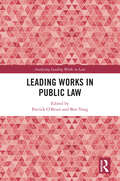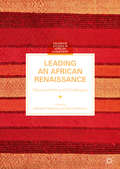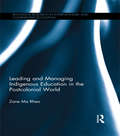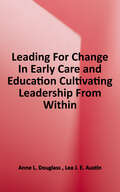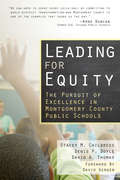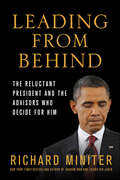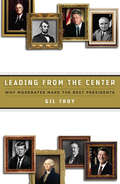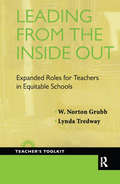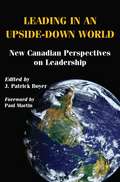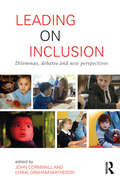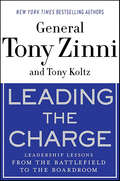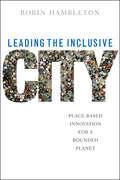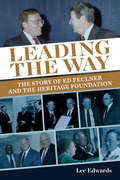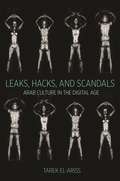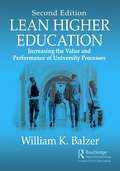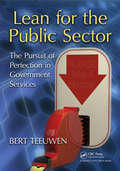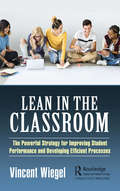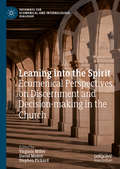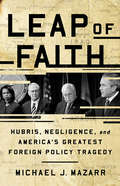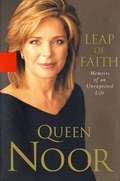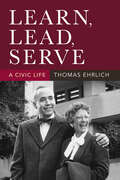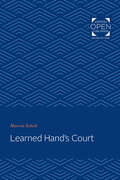- Table View
- List View
Leading Works in Public Law (Analysing Leading Works in Law)
by Patrick O’Brien and Ben YongThis book brings together a group of leading scholars working in public law and constitutional theory. It examines accepted leading works of public law while also exploring those that deserve greater attention. Over 13 chapters, a group of leading public law experts each examine one leading work from the UK public law canon. Each chapter critically reflects on the context of a work in public law, taking into account not just the work and its context but also how it shapes and contributes to the broader discipline. The final chapter offers an international overview of the chapters themselves, reflecting critically on the scholarly canon of UK public law from the perspective of American constitutional scholarship. The book will be of interest to scholars and students of constitutional law.
Leading an African Renaissance
by Kathleen Patterson Bruce WinstonThis book looks at the challenges and possibilities facing leadership in Africa today by providing a rich history of the continent, the complexities the continent has experienced, and the great hope and encouragement that remains. It explores what African leadership is and the possible effects it has on leaders, followers, and organizations across the continent. While some maintain that leadership of and within Africa presents too many challenges, this book argues that Africa is ripe with potential and on the verge of an African Renaissance. This book looks beyond socioeconomic factors to explore different perspectives of leadership such as holistic, transformational, and servant leadership, as well as values and ethics. Taking a philosophical and pragmatic approach, this edited collection provides insight from African-born leadership scholars to deliver a first-hand account of the challenges the continent faces. Their unique experiences and immersion in the African world pave the way for a revival of leadership through a lens of history, tradition, economics, societal, and leadership perspectives.
Leading and Managing Indigenous Education in the Postcolonial World (Routledge Research in International and Comparative Education)
by Zane Ma RheaThis book brings together the academic fields of educational leadership, educational administration, strategic change management, and Indigenous education in order to provide a critical, multi-perspective, systems level analysis of the provision of education services to Indigenous people. It draws on a range of theorists across these fields internationally, mobilising social exchange and intelligent complex adaptive systems theories to address the key problematic of intergenerational, educational failure. Ma Rhea establishes the basis for an Indigenous rights approach to the state provision of education to Indigenous peoples that includes recognition of their distinctive economic, linguistic and cultural rights within complex, globalized, postcolonial education systems. The book problematizes the central concept of a partnership between Indigenous people and non-Indigenous school leaders, staff and government policy makers, even as it holds this key concept at its centre. The infantilising of Indigenous communities and Indigenous people can take priority over the education of their children in the modern state; this book offers an argument for a profound rethinking of the leadership and management of Indigenous education. Leading and Managing Indigenous Education in the Postcolonial World will be of value to researchers and postgraduate students focusing on Indigenous education, as well as teachers, education administrators and bureaucrats, sociologists of education, Indigenous education specialists, and those in international and comparative education.
Leading for Change in Early Care and Education: Cultivating Leadership from Within (Early Childhood Education Ser.)
by Anne L. DouglassFeaturing both research findings and practical recommendations, this book presents an innovative framework for nurturing leadership in the care and education of young children. Early educators are often seen as the objects of change, rather than the architects and co-creators of change. Douglass calls for a paradigm shift in thinking that challenges many long-held stereotypes about the early care and education workforce's capacity to lead change. Case studies show how educators use their expertise every day to make a difference in the lives of children and families. These accounts demonstrate concrete strategies for expanding current thinking about who can be leaders for change and for developing more inclusive pathways for leadership. This book has the potential to revolutionize the field with a new model for developing and nurturing innovative, entrepreneurial, and skilled early educator leaders capable of driving transformative change-from classrooms and home-based programs to communities and beyond. Includes a cross-disciplinary examination of leadership, improvement, and innovation, a framework for building ecosystems that supports professional growth and teacher retention, case studies that reveal immense untapped potential from within the early care and education workforce, and a critical look at the current state of leadership and quality improvement in early childhood education.
Leading for Equity: The Pursuit of Excellence in the Montgomery County Public Schools
by David Gergen David A. Thomas Stacey M. Childress Denis P. DoyleLeading for Equity tells the compelling story of the Montgomery County (Maryland) Public Schools and its transformation--in less than a decade--into a system committed to breaking the links between race and class and academic achievement. In chapters organized around six core themes, the authors lay out the essential elements of MCPS's success. They identify key lessons other districts can draw from MCPS's experience and offer a framework for applying them. A dramatic departure from "business as usual," MCPS has won nationwide attention as a compelling model for tackling the achievement and opportunity issues that confront our nation as a whole.
Leading for Equity: The Pursuit of Excellence in the Montgomery County Public Schools
by David A. Thomas Stacey M. Childress Denis P. DoyleLeading for Equity tells the compelling story of the Montgomery County (Maryland) Public Schools and its transformation—in less than a decade—into a system committed to breaking the links between race and class and academic achievement. In chapters organized around six core themes, the authors lay out the essential elements of MCPS&’s success. They identify key lessons other districts can draw from MCPS&’s experience and offer a framework for applying them. A dramatic departure from &“business as usual,&” MCPS has won nationwide attention as a compelling model for tackling the achievement and opportunity issues that confront our nation as a whole.
Leading from Behind: The Reluctant President and the Advisors Who Decide for Him
by Richard MiniterBarack Obama has never been fully vetted—until now. In the New York Times bestselling Leading from Behind, investigative journalist Richard Miniter presents the first book to explore President Obama's abilities as a leader, by unearthing new details of his biggest successes and failures. Based on exclusive interviews and never-before-published material, Leading from Behind investigates the secret world of the West Wing and the combative personalities that shape historic events. Contrary to the White House narrative, which aims to define Obama as a visionary leader, Leading from Behind reveals a president who is indecisive, moody, and often paralyzed by competing political considerations. Many victories—as well as several significant failures—during the Obama presidency are revealed to be the work of strong women, who led when the president did not: then-Speaker Nancy Pelosi; Secretary of State Hillary Clinton; and Valerie Jarrett, his closest adviser and an Obama family confidante, whose unusual degree of influence has been a source of conflict with veteran political insiders.In Leading from Behind, you will learn:· Why Obama's relationship with Israel was poisoned years before he met Israel's prime minister Benjamin Netanyahu· The real reason for Valerie Jarrett's strong hold over both Barack and Michelle Obama· ObamaCare wasn't Obama's idea. It was House Speaker Nancy Pelosi's. And the real reason he danced to her tune.· Obama delayed and canceled the mission to kill Osama bin Laden three times and then committed an intelligence blunder that allowed dozens of high-level members of al Qaeda to escape.· Why Obama destroyed a secret budget deal with House Speaker John Boehner that would have reformed entitlements, slashed spending, and reduced the national debt—without raising taxes· Why Obama is determined to save Attorney General Eric Holder, even though he has mislead and stonewalled Congress about "Operation: Fast and Furious"· Why Obama decided to defy the Tea Party and ditch his plans to end earmarksIn Leading from Behind, Richard Miniter's provocative research offers a dramatic, thoroughly sourced account of President Obama's White House during a time of intense domestic controversy and international turmoil.
Leading from Within: Conscious Social Change and Mindfulness for Social Innovation (The\mit Press Ser.)
by Gretchen Ki SteidleA roadmap for integrating mindfulness into every aspect of social change: how to lead transformation with compassion for the needs and perspectives of all people.Gretchen Steidle knows first-hand the personal transformation that mindfulness practice can bring. But she doesn't believe that transformation stops at personal wellbeing. In Leading from Within, Steidle describes the ways that personal investment in self-awareness shapes leaders who are able to inspire change in others, build stronger relationships, and design innovative and more sustainable solutions. Steidle argues that both personal and societal transformation are essential for a just society, and with this book she offers a roadmap for integrating mindfulness into every aspect of social change. Conventional methods attempt to compel people to change through incentives or punitive measures. Conscious social change calls for leading with a deeper human understanding of change and compassion for the needs and perspectives of all stakeholders.Steidle offers mindfulness practices for individuals and groups, presents the neuroscientific evidence for its benefits, and argues for its relevance to social change. She describes five capacities of conscious social change, devoting a chapter to each. She writes about her own experiences, including her work helping women to found their own grassroots social ventures in post-conflict Africa. She describes the success of a group of rural, uneducated women in Rwanda, for example, who now provide 9,000 villagers with clean water, ending the sexual exploitation of disabled women unable to collect water on their own. Steidle also draws from the work of change agents in the United States to showcase applications of conscious social change to timely issues like immigration, racism, policing, and urban violence. Through personal stories and practical guidance, Steidle delivers both the inspiration and tools of this innovative approach to social transformation.About Global Grassroots: In post-conflict Africa, Global Grassroots equips emerging women leaders, including war survivors, subsistence farmers, and the undereducated, with the tools and resources to create conscious social change. Our core program is our Academy for Conscious Change, a social entrepreneurship and mindfulness-based leadership program that helps vulnerable women design their own non-profit solutions to address priority social issues. In our first decade of operations we have trained over 650 change agents who have designed 150 civil society organizations benefiting over 150,000 people.
Leading from the Center: Why Moderates Make the Best Presidents
by Gil TroyGeorge Washington, Abraham Lincoln, Theodore Roosevelt, Franklin Delano Roosevelt, John F. Kennedy-most would agree their presidencies were among the most successful in American history. But what made these very different men such effective leaders? According to presidential historian Gil Troy, these presidents succeeded not because of their bold political visions, but because of their moderation. Although many of the presidential hopefuls for 2008 will claim to be moderates, the word cannot conceal a political climate defined by extreme rhetoric and virulent partisanship. In Leading From the Center, Gil Troy argues that this is a distinctly un-American state of affairs. The great presidents of American history have always sought a golden mean-from Washington, who brilliantly mediated between the competing visions of Thomas Jefferson and Alexander Hamilton, to Lincoln, who rescued the Union with his principled pragmatism, to the two Roosevelts, who united millions of Americans with their powerful, affirmative, nationalist visions. As America lines up to select a president for the future, Gil Troy astutely reminds us of the finest traditions of presidential leadership from our nation's past.
Leading from the Inside Out: Expanded Roles for Teachers in Equitable Schools
by David Grubb Lynda TredwayThis book proposes that the collective responsibility of teachers as classroom and school leaders working together to solve their own problems provides the fulcrum of school change. It makes the case that teachers and school leaders do not operate in a vacuum, but rather, they work within the larger context of policy and other social influences. Grubb and Tredway provide the building blocks of history, policy, and social analysis that are necessary if teachers are to be effective in the collective school a place where adults thrive as learners and are able to co-create joyful learning experiences for children and youth. By encouraging teachers to move out of the individual classroom and to think critically and institutionally about the schools they would like to work in, about their own responsibilities for creating such schools, about the range of policies from outside the school and how they can influence those policies rather than being subjected to them this book shows that a teacher s influence is not limited to the classroom and students, but can significantly shape and inform external policies and decisions."
Leading in an Upside-Down World: New Canadian Perspectives on Leadership
by J. Patrick Boyer The Right Honourable Paul MartinThe world as we know it has been turned upside down by recent events but it’s still a place where leadership is needed more than ever. Fifteen Canadians with highly diverse perspectives and richly different experience explore this timely question in Leading in an Upside-Down World. Chapter by chapter, stories of Canada unfold and future prospects for leadership grow clearer as these eminent Canadians explain how to "recognize leadership" in an age where old institutions and behaviours are being left behind. They also identify leadership attributes that endure. Leading in an Upside-Down World gives voice to both scholars and practitioners of Canadian-style leadership.
Leading on Inclusion: Dilemmas, debates and new perspectives
by Lynne Graham-Matheson John CornwallLeading on Inclusion: Dilemmas, debates and new perspectives critically examines the current theory and legislative context of special educational needs and disability, and explores the enduring issues and opportunities that will affect future practice in all schools. The central theme throughout the book asks the inevitable question ‘What happens next?’ and the expert team of contributors, drawn from a pool of teachers, academics and researchers, consider wide-ranging issues such as: the voice of young people whole school development and planning for inclusion educational change within the context of inclusion the pros and cons of multi-professional working inclusive and ethical research international perspectives on inclusion, SEN and disability the development of teacher education and the notion of ‘joined up’ thinking. This forward-thinking and rigorously researched book will be essential reading for students, teachers undertaking school-based training, SENCOs, inclusion managers, higher education tutors and anyone with a professional interest in the future for inclusive education.
Leading the Charge: Leadership Lessons from the Battlefield to the Boardroom
by Tony Koltz Tony Zinni"What's happened to our leaders and to our leadership?"Based on General Zinni's leadership experiences from the battlefield to the boardroom, Leading the Charge shows a new way through the significant leadership challenges of the 21st century.The times are changing at an ever-increasing velocity. Old systems, organizations, and ways of operating no longer work in our dynamic, complex and increasingly unstable new environment. Out of this chaos and confusion, a new and different leader must emerge. Old systems and methods will no longer work. Leading the Charge is a visionary leadership book that examines the trends that have reshaped our world and the ways in which visionary leaders and organizations can effectively respond. Tomorrow's successful leaders--in all fields, including the military, academia, politics, and business--must know how to create, operate, and thrive in very fluid, flattened, and integrated structures that are remarkably different from the traditional organizations we are used to seeing. They will have to manage rapidly changing technology and flows of information, and create faster and more far-reaching spans of control. Leading the Charge shows the way, and is an incisive and compelling guide to the new world of leadership, one that will prove indispensable for years to come.Organized around "Leading a New World," a revolutionary leadership course General Zinni developed and taught at the Terry Sanford Institute of Public Policy at Duke University, Leading the Charge makes a convincing case that leaders must . . . - change with the times to be relevant.- be ready for crisis mode at any given time.- have a moral compass and the ability to steer the company in the right direction.- be forward thinking, not reactive, to provide innovation and creativity.- develop great leaders.
Leading the Inclusive City: Place-Based Innovation for a Bounded Planet
by Robin HambletonCities are often seen as helpless victims in a global flow of events and many view growing inequality in cities as inevitable. This engaging book rejects this gloomy prognosis and argues that imaginative place-based leadership can enable citizens to shape the urban future in accordance with progressive values – advancing social justice, promoting care for the environment and bolstering community empowerment. This international and comparative book, written by an experienced author, shows how inspirational civic leaders are making a major difference in cities across the world. The analysis provides practical lessons for local leaders and a significant contribution to thinking on public service innovation for anyone who wants to change urban society for the better.
Leading the Way
by Lee EdwardsThe remarkable history of The Heritage Foundation, its influential founder, and the conservative movement in America.Leading the Way tells the story of how Ed Feulner has transformed policymaking in Washington and has led The Heritage Foundation into becoming the most influential conservative think tank in the nation. Under Ed Feulner and for 36 years, Heritage has shaped politics with conservative solutions for such critical issues as entitlements, national security, missile defense, health care, welfare reform, immigration, free trade, energy, and the role of the family and religion in society. Today, with over hundreds of thousands of members and an annual budget of more than $80 million, Heritage is a permanent Washington institution and the leading exponent of conservative ideas in America and around the world. The man who made it happen is Ed Feulner, intellectual entrepreneur, hands-on manager, legendary fundraiser, presidential adviser, bestselling author, and world traveler--a man who never stops and was described by The Economist as "one of the most influential conservatives in America."
Leading with Feminist Care Ethics in Higher Education: Experiences, Practices, and Possibilities
by Christie SchultzThis book explores how academic leaders throughout higher education experience and practice care and the ethics of care. Drawing on a narrative inquiry study of experiences and practices of feminist care ethics in higher education leadership, Schultz counters academic norms, including expectations of competition and criticism across all activities, by uncovering the common experiences of academic leaders who intentionally adopt practices guided by an ethics of care and relationality. Within the context of institutions of higher education responding to present-day social movements, the book highlights how practices of care-centered leadership can enable change that begins on campus and reaches outwards to positively impact the community.
Leaks, Hacks, and Scandals: Arab Culture in the Digital Age (Translation/transnation Ser. #40)
by Tarek El-ArissHow digital media are transforming Arab culture, literature, and politicsIn recent years, Arab activists have confronted authoritarian regimes both on the street and online, leaking videos and exposing atrocities, and demanding political rights. Tarek El-Ariss situates these critiques of power within a pervasive culture of scandal and leaks and shows how cultural production and political change in the contemporary Arab world are enabled by digital technology yet emerge from traditional cultural models.Focusing on a new generation of activists and authors from Egypt and the Arabian Peninsula, El-Ariss connects WikiLeaks to The Arabian Nights, Twitter to mystical revelation, cyberattacks to pre-Islamic tribal raids, and digital activism to the affective scene-making of Arab popular culture. He shifts the epistemological and historical frameworks from the postcolonial condition to the digital condition and shows how new media challenge the novel as the traditional vehicle for political consciousness and intellectual debate.Theorizing the rise of “the leaking subject” who reveals, contests, and writes through chaotic yet highly political means, El-Ariss investigates the digital consciousness, virality, and affective forms of knowledge that jolt and inform the public and that draw readers in to the unfolding fiction of scandal.Leaks, Hacks, and Scandals maps the changing landscape of Arab modernity, or Nahda, in the digital age and traces how concepts such as the nation, community, power, the intellectual, the author, and the novel are hacked and recoded through new modes of confrontation, circulation, and dissent.
Lean Higher Education: Increasing the Value and Performance of University Processes, Second Edition
by William K. BalzerIn an environment of diminishing resources, growing enrollment, and increasing expectations of accountability, Lean Higher Education: Increasing the Value and Performance of University Processes, Second Edition provides the understanding and the tools required to return education to the consumers it was designed to serve – the students. It supplies a unifying framework for implementing and sustaining a Lean Higher Education (LHE) transformation at any institution, regardless of size or mission. Using straightforward language, relevant examples, and step-by-step guidelines for introducing Lean interventions, this authoritative resource explains how to involve stakeholders in the delivery of quality every step of the way. The author details a flexible series of steps to help ensure stakeholders understand all critical work processes. He presents a wealth of empirical evidence that highlights successful applications of Lean concepts at major universities and provides proven methods for uncovering and eliminating activities that overburden staff yet contribute little or no added value to stakeholders. Complete with standardized methods for correctly diagnosing workplace problems and implementing appropriate solutions, this valuable reference arms you with the understanding and the tools to effectively balance the needs of all stakeholders. By implementing the Lean practices covered in these pages, your school will be better positioned to provide higher quality education, at reduced costs, with efficient processes that instill pride, maximize value, and respect the long-term interests of your students, faculty, and staff. This second edition contains a substantial update with expanded material and reflects the significant growth of LHE practices in colleges and universities worldwide. Because of advances in best practices, as well as some modest research-based evidence, this second edition includes many enhancements that provide particular value to LHE practitioners and higher education (HE) leaders. Since the initial publication of Lean Higher Education in 2010, the challenges of cost and affordability, competition for students and faculty, and calls for efficiency and accountability have only continued to grow, requiring colleges and universities to pursue more radical and transformative change to ensure their success. This new edition provides a model for change based on more than 50 years of application in business and industry and almost 20 years in HE. It provides the information and evidence demanded by HE leadership to understand and embrace LHE as well as best practices processes and tools for implementing LHE in targeted areas or institution-wide. This book provides a conceptual framework for redesigning any university process, such as admitting students, paying a bill, hiring faculty, or processing a donor gift, in a way that delights the beneficiary of that process, respects the employees who support the process, and reduce the cost of the process.
Lean for the Public Sector: The Pursuit of Perfection in Government Services
by Bert TeeuwenPacked with international case examples and clearly delineating principles as they apply to public sector organizations, Lean for the Public Sector: The Pursuit of Perfection in Government Services demonstrates that Lean in the public sector is neither rocket science nor a typical profit-driven improvement program. The book begins with coverage of
Lean in the Classroom: The Powerful Strategy for Improving Student Performance and Developing Efficient Processes
by Vincent WiegelLean in the Classroom: The Powerful Strategy for Improving Student Performance and Developing Efficient Processes – Wiegel -- ISBN 9781138323131 - CAT# K392041 The current way of organizing education is not tenable in the coming decade. We need to address how we teach, how we organize schools, how we increase the effectiveness of learning, how we construct classrooms, and how we deploy new technologies. Lean management philosophy has been successfully applied across many industries – from manufacturing to healthcare, financial services, and construction. Recently, interest in Lean has steadily increased in the education sector, as it was originally introduced in that area’s administrative and support processes. Currently, the introduction of Lean and its potential in education is gaining wider exposure because of massive looming changes – for example, the introduction of technology in education (as EdTech within the traditional system and as MOOCs), demographic changes, budget pressure, new pedagogies, the entrance of more and more private providers, and changing demands of society and industry on the curriculum. What is missing is a joint framework that will allow schools, teachers, directors, and boards to harness the potential of these developments and then execute a strategy. Lean Education (LE) offers the potential to streamline the execution of strategy and teaching. It accelerates the development of new courses and studies that are closely aligned to the needs of students. It supports the integration of new technologies without overburdening teachers and staff. Lean in the Classroom brings all these elements together into a coherent framework so schools can make necessary changes in one concerted effort. Teaching, professional support, managing the daily work, and changing the way schools function are brought together as a schoolwide strategy to organize learning in a way that serves our students by making the most of their talents. This book is the first to define LE in all its aspects: course design, actual teaching and learning processes, school management, and the organization of supporting processes. It is firmly based on the Lean management philosophy in conjunction with pedagogy. The book draws on both scientific research in the field of Lean management in general and Lean education in particular. In addition, it is predicated on many years of hands-on experience applying Lean both inside and outside the education sector.
Leaning into the Spirit: Ecumenical Perspectives on Discernment and Decision-making in the Church (Pathways for Ecumenical and Interreligious Dialogue)
by David Moxon Virginia Miller Stephen PickardThis book contains fresh insights into ecumenism and, notwithstanding claims of an “ecumenical winter,” affirms the view that we are actually moving into a “new ecumenical spring.” It offers new theological insights in the areas of Christology, Pneumatology and Trinitarian theology, and discusses developments in ecumenism in the USA, UK, Australia, India, and Africa, as well as in ecumenical institutions such as the World Council of Churches (WCC) and the Anglican Roman Catholic Commission (ARCIC).
Leap of Faith: Hubris, Negligence, and America's Greatest Foreign Policy Tragedy
by Michael J. MazarrThe dramatic insider account of why we invaded Iraq, the motivations that drove it, and the frustrations of those who tried and failed to stop it, leading to the most costly misadventure in US history.A single disastrous choice in the wake of 9/11-the decision to use force to remove Saddam Hussein from power-did enormous damage to the wealth, well-being, and reputation of the United States. Few errors in U.S. foreign policy have had longer-lasting or more harmful consequences. Yet how the decision came to be made remains shrouded in mystery and mythology. To this day, even the principal architects of the war cannot agree on it.Michael Mazarr has interviewed dozens of players involved in the deliberations about the invasion of Iraq and has reviewed all the documents so far declassified. He paints a devastating of portrait of an administration fueled by righteous conviction yet undercut by chaotic processes, rivalrous agencies, and competing egos. But more than the product of one bungling administration, the invasion of Iraq emerges here as a tragically typical example of modern U.S. foreign policy fiascos.Leap of Faith asks profound questions about the limits of US power and the accountability for its use. It offers lessons urgently relevant to stave off similar disasters-today and in the future.
Leap of Faith: Memoirs of an Unexpected Life
by Queen NoorA dramatic and inspiring story of Arab-American Lisa Halliby, her marriage to King Hussein, humanitarian activist in a court where women are only expected to keep their husbands happy.
Learn, Lead, Serve: A Civic Life
by Thomas EhrlichThomas Ehrlich served in the federal administrations of six presidents, beginning with Kennedy in 1962. He was also Dean of Stanford Law School, Provost of the University of Pennsylvania, President of Indiana University, and one of the pioneers of the service-learning movement. Weaving together memorable family stories and valuable professional insights, Ehrlich tells how he developed the knowledge and skills to be a leader in both government and higher education, the lessons he learned in those roles, and the many ways he and his wife Ellen balanced family life and civic service along the way. Warmly written and brimming with fascinating, behind-the-scenes details, Learn, Lead, Serve is both a celebration of an accomplished career and an inspiring lodestar for those wanting to follow the path of public service.
Learned Hand's Court
by Marvin SchickOriginally published in 1970. This is a study of one of the most highly respected tribunals in the history of the English-speaking world—the United States Court of Appeals for the Second Circuit. Situated in Manhattan, the Second Circuit Court, serving New York, Connecticut, and Vermont, is the most important commercial court in the country. But, like other inferior courts, it has never been studied in depth. Marvin Schick provides a comprehensive analysis. From 1941 to 1951, Learned Hand presided over the Second Circuit as chief judge, and the court bore his stamp. But on its bench sat other men of great competence, judges Thomas W. Swan, August N. Hand, and Harrie B. Chase, as well as Charles E. Clark and Jerome N. Frank, whose constant disagreement characterized much of the court's work. Schick studies the Second Circuit Court from several angles: historical, biographical, behavioral, and case analytical. He tells a history of the court from its origins in 1789. He provides biographical sketches of the six judges who sat during Learned Hand's tenure as chief judge. He analyzes the many decisions handed down by the court, including the precedent setters. He examines the court's decision-making process, especially its unique procedures such as the memorandum system, which requires from the judges "preliminary opinions" in the cases they hear. A novel feature of this book is the correlation of votes of the Second Circuit judges with subsequent decisions of the Supreme Court.Schick was aided in his study by having access to the private papers of Judge Clark. These thousands of memoranda and letters throw much light on the workings of the Second Circuit Court and reveal the bargaining that went on among the judges in difficult cases. The Clark papers make possible a clearer understanding of the incessant conflict between Clark and Frank and show how this unusual relationship gave vitality to the Second Circuit.
